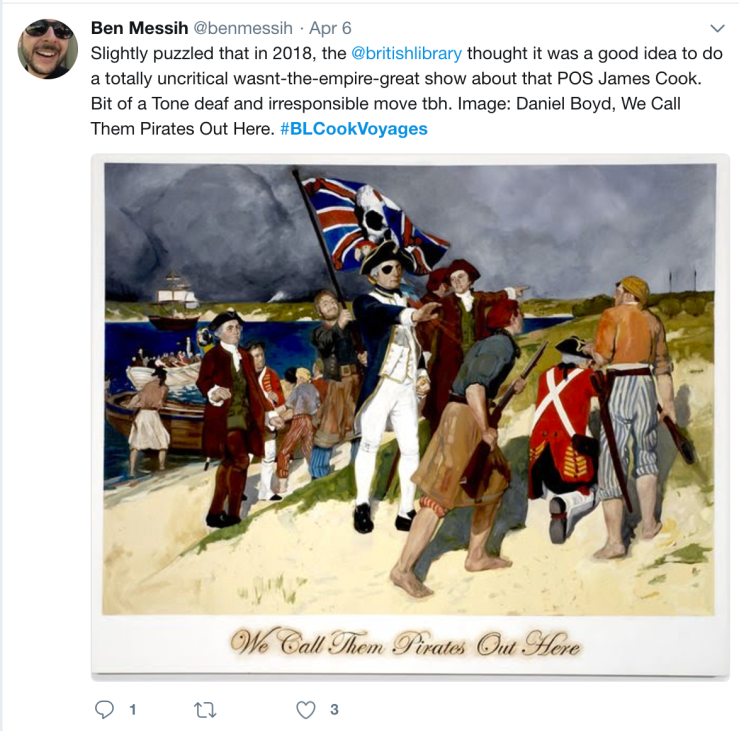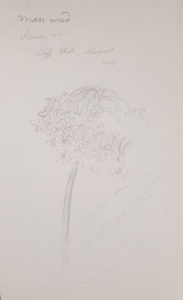Scrolling through my Twitter feed last weekend, a comment caught my eye. The post was written in response to the commemorative exhibition at the British Library on Cook’s Voyages. Here it is:

Although I didn’t get the impression from the online exhibit that “tone deaf” was really an accurate assessment (there are some very poignant interpretations from a non-European perspective), Messih raises a good question, and one that I have turned over in my mind many times in the course of my research: why, in 2018, do we still need to tell the story of the Endeavour voyage? Why do we still need to exhibit collections which are fraught with the legacy of an imperialist agenda?
As Rebecca Solnit so eloquently noted about American society in her recent essay, “Who gets to be the subject of the story is an immensely political question…we’re still struggling over whose story it is, who matters, and who our compassion and interest should be directed at…. The common denominator of so many of the strange and troubling cultural narratives coming our way is a set of assumptions about who matters, whose story it is, who deserves the pity and the treats and the presumptions of innocence… and ultimately the kingdom, the power, and the glory. You already know who. It’s white people in general and white men in particular, and especially white Protestant men… one of the battles of our time is about who the story is about, who matters and who decides.”
So it’s time for me to confront the apparent paradox: why does a modern, college-educated woman who is passionate about human cultural diversity care obsessively about a dead white man whose life was defined by his role on a voyage so often linked to cultural devastation?
It may seem strange, but as an American based in Virginia, Messih’s argument hits home for me on many fronts. In 1997, when I was a freshman at Mary Washington College studying historic preservation, I recall my Guatemalan roommate’s horror over the continued presence of a slave auction block on a busy corner of downtown Fredericksburg. I later transferred colleges, and one of my Randolph-Macon Woman’s College classmates is now an archaeologist with Jamestown Rediscovery, excavating the original British settlement of 1607 and documenting examples of cross-cultural exchange and conflict (as well as the origins of American slavery) within the remains of the fort. I live an hour from Charlottesville, where last year riots broke out over the proposed removal of Confederate monuments from a city park. And my husband grew up in the shadow of Bear Mountain, the sacred home of the Monacan Nation. He saw firsthand the terrible impact of three centuries of persecution and forced assimilation on the native peoples of our state. The role of material culture in perpetuating (and aggravating) social memory has been a consistent motif in my own experience.
So here is why I think the Endeavour (and similar “voyages of discovery”) still deserves our attention. Understanding moments of contact–the initial encounter between two cultures, at a point where their shared histories were as yet undecided–is crucial now, as we strive to move forward in a world that is the highly globalized product of the cultural conflicts wrought by the imperial paradigm. If we are to find empathy for the “other” in our own lives (whoever the “other” might be), we need to understand the perceptions, preconceptions and misconceptions of every human perspective at moments in our history where one culture first encountered another, the moment in which the unexpected presence of one first impacted the fate of the other. As I have discussed in other posts, my work focuses on Sydney Parkinson’s perspective because I can easily relate to it; without making assumptions regarding other experiences of Endeavour, I can engage with the work and input of other researchers who have better insight into these very divergent perspectives in order to create a wholistic and nuanced narrative.
It is easy to fall into the trap of implicating every person aboard the Endeavour for the subsequent abuse of generations of Pacific peoples. We desperately need to hear the voices of the descendants of the oppressed or dispossessed. At the same time, a wholesale discounting of the perspective of those people who were “privileged” or “dominant” as irrelevant is an easy way to make ourselves feel morally vindicated, but it neglects to consider the incredible complexity of such historical narratives. Acknowledging this complexity is vitally important if we are to make sense of the biases in both primary source documents and oral histories. Many assume that, because we have heard Cook’s perspective or Banks’s perspective, that we have heard all the British had to say, and that our interpretations of what they said or done have been infallible. (For just one example of interpretation that has been consistently flawed, with significant impact on overall meaning, see here.) Yet the men of the Endeavour came from backgrounds as diverse as England itself (and even more so, once the Tahitians Tupaia and Taiata joined the crew). Some, like Banks, were indeed wealthy, privileged, and motivated by imperialist opportunities. But others were poor, and service at sea was a way to escape the fetid slums of London while guaranteed regular meals, fresh air, exercise and employment. Some (like Parkinson) were of the middle ground: privileged to have the patronage of the wealthy on account of their skills and insight, but regarded as socially inferior and denied a degree of autonomy as a result. Some had high ambitions within the British Navy, and sought preference for advancement; others (Tom Richmond and George Dorlton) were black “servants”–possibly slaves–who had little or no choice in their participation on the voyage. Many of these men were young and optimistic, and were motivated by the hope of attaining new knowledge or experiences. They were attracted by the prospect of adventure; like many energetic young men, they wanted to travel to exotic places, meet new people, discover “wilderness”, and thrill at the occasional adrenaline rush. Sydney Parkinson captured his own idealistic ambitions early in the voyage: “A curiosity, perhaps, equal to Solomon’s, though accompanied with less wisdom than was possessed by the Royal Philosopher, induced some of us to quit our native land, to investigate the heavenly bodies minutely in distant regions, as well as to trace the signatures of the Supreme Power and Intelligence throughout several species of animals, and different genera of plants in the vegetable system” (21 January 1769). The assiduousness with which he absorbed native languages, the general absence of Europeans in his illustrations, and the fact that he shared paints and paper with Tupaia suggests that Parkinson wanted very much to understand this “new world” from the perspective of those who had inhabited it for many centuries. Parkinson, like many of us, longed to make a positive impact, to live a life that wasn’t merely adequate but truly meaningful.
It is easy to forget this fact, to assume that these men were merely inhuman colonizers bent on appropriation and destruction, because to acknowledge their normality is to acknowledge that we ourselves could fail in our efforts to make the world better. Even with the best of intentions, we might one day find ourselves caught in the inertia of events which are spiraling out of our own control, with lasting effects we neither envisioned nor intended (as Sydney Parkinson frequently did). We would have to acknowledge that all the positive achievements we make–the richness of our own legacies–might one day be dismissed out of hand by later generations who, rather than confronting their own human fallibility, prefer to fix blame on us for the many ways in which we fell short of their ideals.
And that is why, in 2018, we still need to hear the British narratives together with those of Tupaia, Te Horeta, or their cultural descendants: to retain the perspective that humanity is complex, that no human encounter is ideal, and no history is ever complete. We need to be reminded of this daily in our own lives. We need to strive to hear ever more voices, not merely different ones. And we need to strive, always, to see both our achievements and our failures in a clearer light.
ADDED: For a thought-provoking approach to concepts of exploration and the continued relevance of exploration history (in this case considering Lewis & Clark and Alexander von Humboldt), read Michael F. Robinson’s essay, “Why we need a new history of exploration.”
As ever, I would love to hear your thoughts! Feel free to email me at esmith@randolphcollege.edu .

